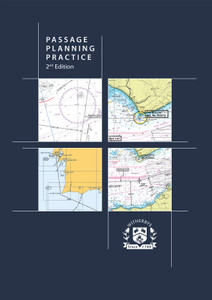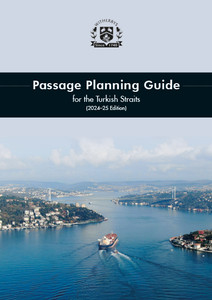
This 2024 edition sets out procedures for the correct configuration of ECDIS and, utilising the APEM (appraisal, planning, execution and monitoring) methodology, highlights best practices for passage planning and watchkeeping.
This publication equips navigators with a thorough knowledge of ECDIS, contributing towards safer navigation and a more effective bridge team. It encourages operators to practise using every function and technique available on ECDIS, such as new automatic functions for creating 'no-go' alarms, 3D ENC functionality and use of VHF. A revised introduction chapter details the latest IMO Performance Standards for ECDIS equipment.
The 2024 edition also includes a new chapter on Port State Control, Audits and Verifying Compliance. The verification checks are split according to ECDIS and Passage Planning verification, with the latter following the APEM structure. Each area of inspection is covered, with guidance included on how to conduct the checks.
Updated ECDIS screenshots, expanded NAVTEX content and illustrations such as the PSC flowchart aid readers' understanding of best practice techniques.
This edition of 'ECDIS Passage Planning and Watchkeeping' sets out procedures for the correct configuration of ECDIS and, utilising the APEM methodology, highlights best practices for passage planning and watchkeeping.
An ECDIS operator should:
Be proficient in setting up the ECDIS, particularly the safety and display settings
be aware that, while ECDIS may continuously display a ?position?, it is important to understand how that position has been derived and how to verify its accuracy. The key to effective ECDIS navigation is ?position verification? of the current GNSS position. The watchkeeper must regularly verify the GNSS position with LOPs from an alternative positioning method.
Practising the use of every function and technique available on the ECDIS is one of the most effective ways a watchkeeper can maintain and develop their navigation skills at sea. Learning how to use each type of ECDIS thoroughly, and mentoring others to do the same, contributes towards safer ship operation and a more effective bridge team.
In November 2021, the UK Supreme Court reaffirmed the decision that a defective passage plan effectively renders the ship legally unseaworthy. In the case under question, a large container ship went aground. The company was held liable for several million dollars when it was determined that the chart had not been properly updated. It was found that the passage plan (appraisal and planning stages) and subsequent navigation outside a buoyed fairway did not reflect a warning given in a Notice to Mariners. The warning stated that the depths shown on the chart outside the fairway were unreliable and that the waters were shallower than those recorded on the chart.
Definitions
Abbreviations
ECDIS Passage Planning and Watchkeeping
1 ECDIS and Passage Planning Requirements
Introduction
1.1 ECDIS Requirements
1.2 ECDIS Standards
1.2.1 IMO Standards
1.2.2 IHO Standards
1.3 ECDIS Training
1.4 The Components of ECDIS
1.5 APEM Passage Planning
1.6 Effective Planning on ECDIS
2 Configuration of ECDIS Settings
Introduction
2.1 Configuration of ECDIS Sensors
2.1.1 CCRP and Technical Set-up
2.1.2 Sensor Settings
2.1.3 ECDIS Alert Management
2.2 Depth Contours and Safety Settings
2.3 Safety Settings Calculations
2.3.1 Datums and Vertical Clearance
2.3.2 Safety Contour and Safety Depth
2.4 Cross Track Distance (XTD)/Safety Corridor
2.5 Detection Area
2.6 Navigational Hazards
2.7 Isolated Dangers
2.8 Areas for which Special Conditions Exist
2.9 Chart Display Settings
2.9.1 System Units
2.9.2 ENC Loading Options
2.9.3 Display Category
2.9.4 Two/Four Colour Shading
2.9.5 Further Display Settings
2.9.6 SCAMIN and SCAMAX
2.9.7 Symbols
2.9.8 Standardisation of Symbols, Terms and Abbreviations (S-Mode)
2.9.9 Palette
2.9.10 Chart Legend
2.9.11 Environmental Data
2.10 Ship Display Parameters
2.11 Route Display Parameters
2.11.1 Route Alarms
2.11.2 Other Display Options
3 Appraisal/Information Gathering
Introduction
3.1 Overview of Appraisal Research
3.2 Destination
3.3 Meteorology
3.3.1 Passage Planning on ECDIS in Ice Regions
3.4 Datums
3.5 ENC Scales and Usage Bands
3.5.1 HD ENCs
3.5.2 Example of Usage Bands
3.5.3 ENC Review
3.6 ENC Management and Installation
3.7 ENC Updates
3.7.1 Chart Subscription Expiry
3.8 CATZOC Review
3.9 Pick Reports
3.10 Other Considerations
4 Planning the Voyage
Introduction
4.1 Display Configuration
4.1.1 NAVTEX
4.1.2 Admiralty Information Overlay (AIO)
4.2 Route Creation
4.2.1 New Route
4.2.2 Adding Waypoints
4.2.3 Adjusting Waypoints
4.2.4 Route Table
4.3 Mariner-added Objects
4.4 Manual ENC Updates
4.5 Route Check
4.5.1 Configuration of the Route Check
4.5.2 Conducting the Route Check
4.5.3 Manual (Visual) Check
4.6 Route Management and the Voyage Plan
4.7 Master?s Approval and Bridge Team Briefing
5 Execution
6 Monitoring
Introduction
6.1 ECDIS Handover
6.2 Position Monitoring and Verification of the GNSS
6.2.1 Verification Methods
6.2.2 Position Verification Frequency
6.2.3 Position Verification Summary
6.3 Other Watchkeeping Considerations
6.3.1 Waypoint Passing Criteria
6.3.2 ECDIS and Track Control Systems
6.3.3 Magnetic Compass
6.3.4 ECDIS Safety Settings and Change of Orders
6.3.5 Alarms and Alerts
6.4 Managing the ETA
6.5 ARPA and AIS Overlay
6.5.1 Radar Information
6.5.2 Chart Radar
6.5.3 AIS Integration with ECDIS
6.5.4 AIS Aids to Navigation (AIS AtoNs)
6.6 Anchor Watch Monitoring
6.7 ECDIS Additional Functionality
6.7.1 SAR Patterns
6.7.2 Man Overboard (MOB)
6.7.3 3D Charts
6.7.4 VHF
6.8 Logbook, ECDIS Voyage Recording and Playback
6.9 Sensor Failure
6.9.1 Heading and Speed Failure
6.9.2 GNSS Failure
6.9.3 Other Sensor Failure
6.10 ECDIS Failure
6.10.1 Software and Hardware Failure
6.11 Cyber Security
6.11.1 Security Drill ? ECDIS Cyber Security
6.12 Pilotage Considerations
6.13 Effective Monitoring
7 Preparation for PSC, Audits and Inspections
Introduction
7.1 Overview of ECDIS and Passage Planning Checks
7.1.1 Summary of ECDIS Verifications
7.1.2 Summary of Passage Planning Verifications
7.1.3 Port State Control and Audits
7.2 ECDIS System Requirements
7.3 ECDIS Backup Requirements
7.4 ENC Requirements
7.5 ECDIS Operator Requirements
7.6 Voyage Appraisal Requirements
7.7 Voyage Planning Requirements
7.8 Voyage Execution Requirements
7.9 Voyage Monitoring Requirements
7.10 Verification Summary Checklist
Annexes
A ECDIS Checklists
ECDIS Operator Familiarisation Checklist
ECDIS Appraisal and Planning Checklist
ECDIS Pre-sailing Checklist
ECDIS Safety Settings Checklist
ECDIS Handover Checklist
ECDIS Failure Checklist
GNSS Failure Checklist
Anchorage Checklist
B IMO: ?ECDIS ? Guidance for Good Practice?
C ECDIS-related Extracts from U.S. Chart No. 1
Positions, Distances, Directions, Compass
Natural Features
Cultural Features
Landmarks
Ports
Tides, Currents
Depths
Nature of the Seabed
Rocks, Wrecks, Obstructions and Aquaculture
Offshore Installations
Tracks, Routes
Areas, Limits
Lights
Buoys, Beacons
Fog Signals
Radar, Radio, Satellite Navigation Systems
Services
D Display Options
E S-63 Error Codes and Explanations
F Objects Associated with the Question Mark Symbol
Witherbys titles are developed using scripts developed by technical experts that are peer reviewed within work groups. Typically, they seek to improve understanding of the regulations, recommendations and guidelines issued by Industry.
Witherbys staff have significant expertise in the fields of navigation and hazardous cargoes as well as in the presentation of complex subjects in a graphic and easy to understand manner.
- Number of Pages:
- 306
- Published Date:
- June 2024
- Book Height:
- 305 mm
- Book Width:
- 215 mm
- Weight:
- 1.7 kg
- Author:
Witherby Publishing Group
- Publication Date:
- June 2024
- ISBN:
- 1914993923
- Preview:
- Yes
 Witherbys.com
Witherbys.com





